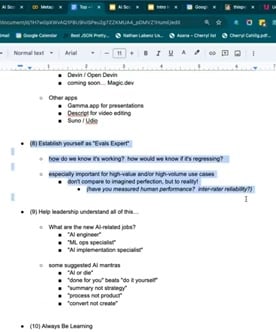How to evaluate AI agents?
Sources:
Evaluating AI agents involves several methods to ensure they function as intended and identify areas for improvement. Here's a summary based on expert discussions:
-
Benchmarks and Evals:
- Establish benchmarks to evaluate AI systems, similar to unit testing, but on an ongoing basis for all inputs and outputs. This helps in understanding if the AI is performing as expected and identifying any deviations 1.
-
Deep Reinforcement Learning Evaluation:
- Assess how well an AI agent approximates the optimality criterion set by its utility function. This includes robustly demonstrating latent capabilities and understanding failure modes 2.
-
Task-Specific Evaluation:
- In complex systems involving multiple agents, each with specific tasks, evaluate each agent individually and collectively assess the overall performance. This ensures each part of the system contributes effectively towards the common goal 3.
-
Robustness and Correctness:
- Beyond initial success rates, it is crucial to ensure AI agents are robust and reliable. This involves improving accuracy from initial levels (like 60-80%) to very high reliability (95-99.99%) for real-world deployment 4.
-
Use of Specialized Agents:
- Employ subagents for specialized tasks under the supervision of a general reasoning layer. Evaluation involves determining how well these subagents perform their tasks and contribute to the overall system's success 5.
-
Iterative Testing and Planning:
- For coding tasks, iterative generation and testing of code help improve performance. Benchmarks like Swebench can be used for initial evaluations, focusing on code planning and developing agents that create and execute detailed plans 6.
-
Scalable Oversight:
- Utilize human oversight to evaluate AI actions, potentially assisted by other AI systems. This involves ensuring humans understand AI proposals and mitigating risks through detailed inspections and training regimens to optimize AI actions based on complex human judgments 7.
These methods collectively ensure comprehensive evaluation, identifying strengths and weaknesses, and guiding improvements in AI agents.
RELATED QUESTIONS-

